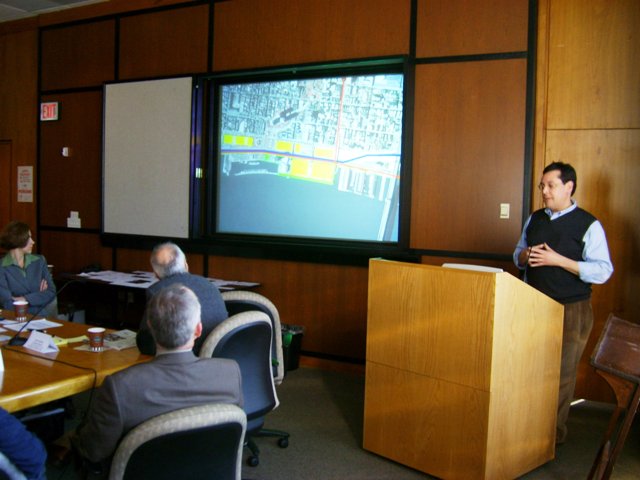Support and caution from Advisory Group

March 5
By Matt Blanchard
For PlanPhilly
At their monthly meeting on Monday, the 45-member Central Delaware Advisory Group embraced the “big ideas” generated by design teams during this weekend’s marathon design workshop.
But they also offered words of caution: Don’t expect to get everything. Don’t forget the community’s voice. And most urgently: Don’t let the big ideas, such as burying Interstate 95, distract the city from badly-needed small ideas.
For example, the present lack of basic zoning controls has already allowed the developers of Waterfront Square to fence off parts of the waterfront that should have been a public trail, said Barry Seymour, executive director of the Delaware Valley Regional Planning Commission.
“Future development will happen while we debate the big ideas,” Seymour said. “Small ideas, like protecting view corridors, public access, a continuous walkway, cost nothing to fix. So while we look large, we’ve also got to look small and act on those ideas now.”
The Advisory Group was formed through Mayor Street’s original order empowering PennPraxis to create a waterfront master plan, and its purpose is to give a voice to stakeholders in government, labor and the neighborhoods.
Monday’s meeting began with a slideshow presentation of ideas generated for five separate segments of the seven-mile study area. Designers studied the North, Central and South portions, as well as Connections from river to city and a waterfront Boulevard to unite the whole.
The boldest ideas to come from the workshop included burying portions of I-95 in Center City to create valuable development parcels and reconnect the city with the river. Another big one was the creation of a European-style boulevard in the place of Delaware Avenue, with a new light rail line linking points along the river to City Hall and 30th Street Station.
From these broad strokes, the scale of ideas ranged down to small details of park design, and ways to make a dynamic experience for pedestrians on their way to the waterfront.
After the presentation, advisory group members seemed cheerful.
“It’s refreshing as a community activist to finally stop saying ‘We can’t do this. We can’t do that.’” said John Scorsone of the River’s Edge Association. “Other cities have a can-do attitude, and that can-do attitude started in Philadelphia. It’s our legacy. We’ve got to get back to that.”
Speaking of the design visions, Scorsone said: “This is absolutely supported by the people of Philadelphia.”
On the other hand, PennDot District 6 director Rina Cutler said she was “leery about a whole lot of it.”
Cutler, who helped manage stages of Boston’s Big Dig, said recent history has not smiled on such plans. If Philadelphia wants to bury our interstate in a similar fashion, finding funding may be impossible. Boston’s project took 20 years and $12 billion.
“The world today is not the world that existed before the Big Dig,” Cutler said. “The federal government stopped funding it a quarter of the way through … And there are a slew of federal rules about interstates you haven’t even begun to trip over.”
Steven Weisler of the Society Hill Civic Association countered that Philadelphia, rarely in danger of being too ambitious, needed bravery more than caution.
“We deserve better in the City of Philadelphia,” Weisler said. “Now is the time to coalesce around a plan, and claim what Philadelphia deserves.”
The next meeting of the Advisory Group is Monday, April 2 at 8 a.m.
WHYY is your source for fact-based, in-depth journalism and information. As a nonprofit organization, we rely on financial support from readers like you. Please give today.






